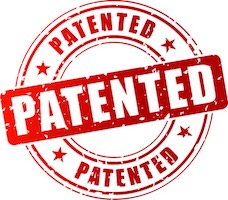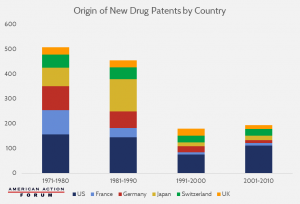Difference between revisions of "Patents"
(→History) |
|||
| Line 3: | Line 3: | ||
==History== | ==History== | ||
| − | Some scholars argue the first legal items that had a role similar to patents were the monopolistic royal grants developed by Queen Elizabeth in 1550 with the intent of advancing her economic and industrial policies in England.<ref>Mossoff, Adam. "Rethinking the Development of Patents: An Intellectual History, 1550-1800," Hastings Law Journal vol. 52, no. 6 (August 2001): p. 1255-1322. HeinOnline, https://libproxy.law.umich.edu:2195/HOL/P?h=hein.journals/hastlj52&i=1285.</ref> Other scholars believe that patents originate from the idea that creativity should be a natural right from fifteenth century Italian city state artisan guilds. Although both | + | Some scholars argue the first legal items that had a role similar to patents were the monopolistic royal grants developed by Queen Elizabeth in 1550 with the intent of advancing her economic and industrial policies in England.<ref>Mossoff, Adam. "Rethinking the Development of Patents: An Intellectual History, 1550-1800," Hastings Law Journal vol. 52, no. 6 (August 2001): p. 1255-1322. HeinOnline, https://libproxy.law.umich.edu:2195/HOL/P?h=hein.journals/hastlj52&i=1285.</ref> Other scholars believe that patents originate from the idea that creativity should be a natural right from fifteenth-century Italian city-state artisan guilds. Although both of these theories have different views about the origins of patients, the emergence of economic incentive to trademark original work became the dominate reason behind the creation of the patent and its intent was for the exclusion of others capitalizing on the invention.<ref>Schaafsma, Paul E. "An Economic Overview of Patents," Journal of the Patent and Trademark Office Society vol. 79, no. 4 (April 1997): p. 241-257. HeinOnline, https://libproxy.law.umich.edu:2195/HOL/P?h=hein.journals/jpatos79&i=246.</ref> |
==Legal== | ==Legal== | ||
Revision as of 12:11, 19 April 2019
Patents are a form of intellectual property(IP) stated in a United States law that precludes other parties from using said property. Although the United States patent originated in April 10, 1790 under the first patent act "An Act to promote the progress of useful Arts", the concept of patents has been traced back to the Venetian Patent Statue of 1474 in Ancient Greece. The patent law system is designed to encourage innovation by incentivizing technological advances with exclusive rights in exchange for public disclosure. Many industries, such as the pharmaceutical industry, rely on the patent law as a major source of competitive advantage. All United States patents are granted through the United States Patent and Trademark Office (USPTO). Patents bring about a number of ehtical issues including patent trolling, unethical pricing, and privacy implications.

Contents
History
Some scholars argue the first legal items that had a role similar to patents were the monopolistic royal grants developed by Queen Elizabeth in 1550 with the intent of advancing her economic and industrial policies in England.[2] Other scholars believe that patents originate from the idea that creativity should be a natural right from fifteenth-century Italian city-state artisan guilds. Although both of these theories have different views about the origins of patients, the emergence of economic incentive to trademark original work became the dominate reason behind the creation of the patent and its intent was for the exclusion of others capitalizing on the invention.[3]
Legal
There are three patentability requirements that must be met in order to form a legal patent: the invention is novel, useful, and non-obvious. In addition to the general requirements, the patent must also be accompanied by a list of claims that define the patent. The claims are technical requirements and outline what features are legally protected by the patent.
If goods are used or sold by another party that violate the claims set forth under a granted patent without the permission of the patent holder, the violating party is infringing the patent and there is grounds for a lawsuit. Patent infringement is a civil law and therefore requires action by the plaintiff to be brought to court. Patents differ by country and therefore patented inventions are free to exploit outside of the controlling government's jurisdiction.
When a patent issue is brought forth, the plaintiff may utilize the following defenses:[4]
- Non-infringement
- Invalidating the patent
- Patent abuse
- Prior use or First Sale Doctrine
The case then proceeds as a standard case in the court of law until either a settlement is reached or the court reaches a decision on the case.
Public Disclosure
Filing a patent application helps inventors prevent others in the public from exploiting their work under the precondition that the inventors disclose their creation publicly in an appropriate time. In most countries, inventors normally are advised not to disclose their work before having the patent if they want their intellectual work to be protected by the patent law. In the United States people who unintentionally disclose their work before filing a patent application have a one year grace period to do so. The unintended disclosures include the On-Sale Bar, the Public-Use Bar, and Printed Publications.[5]
Having a patent also means publicly disclosing the invention under the patent. This means that if a company files for a patent, while their invention or technology is protected for the amount of time under the patent, normally 20 years, it also becomes common knowledge. In recent years we have seen companies decide not to patent their technology because they do not want to give the industry their knowledge, even if it is protected. One of the biggest examples of this is SpaceX. SpaceX is so confident that their technology is so far ahead that they chose not to patent it because they didn't want to make their rocket designs known.
Types of Patents
The three main types of patents are utility patents, design patents, and plant patents. A short-term provisional patent can also be granted during the processing time of each of the above patents. Provisional patents protects the intellectual property of the owner during the patent application process provided the owner can prove they were both in possession of the patent and shown successful use of the invention in a less formal document. Provisional patent protection lasts one year.[6]
Utility Patents
The utility patent is the purest form of the traditional patent outlined in its legal definition. The utility patent exists as a comprehensive technical document of claims that acts both as the public disclosure and scope of the patent. Details such as how to use the invention and its mechanisms are included. The utility patent applies to a wide range of inventions including machines, processes, manufactured goods, and compositions of matter (e.g. pharmaceuticals). Utility patents last 20 years.
Design Patents
Design patents make ornamental design on a useful item into intellectual property and seek to eliminate very close imitation of a novel product. Design patent documents are largely composed of drawings of the submitted design and contain few words. A patent infringement on design patents are not necessarily an exact copy but must only be substantially similar. Design patents last 14 years.
Plant Patents
Plant patents are, as the name denotes, a patent on a plant species created through non-sexual means. Plant patents protect plants created through conventional horticulture and generally do not cover genetically modified organisms. A plant patent lasts 20 years.
Patent Law Ethical Controversies
Although patent law is designed to promote innovation and competition, ethical dilemmas may also arise from its use. The main ethical concerns around the concept of patent law can be defined as ways to abuse the rights granted by patents resulting in social detriment. This can be done through what is known as patent trolling and monopolistic patent pricing.
Patent Trolling
Formally known as patent-assertion entities, patent trolls are companies that accumulate large amounts of patents with no intention to produce or distribute on said patents. Instead, patent trolls seek to bring lawsuits on companies developing products infringing on their patent for profit in the case of a successful suit. Patent trolls may utilize predatory legal practices against smaller or even larger firms to seek settlement. Inefficiencies by the USPTO are also exploited as, despite the long and comprehensive process of filing for a patent, many broad and not strictly "useful" or "non-obvious" patents are produced. Patent trolls do not seek to invest heavily in R&D efforts to develop their portfolio of patents, and opt to buy up patents from smaller companies.
A recent example of a high-profile patent troll case is Apple v VirnetX, where the jury ruled in favor of known patent-assertion firm VirnetX over a patent on secure communications that Apple applications Facetime and iMessage infringed upon. The case concluded after 8 years on April 10th, 2018 and Apple paid $502.6 million to the plaintiff.[7]
The ethical dilemma clearly arises where, in the realm of patent trolls, patents cease to provide public benefit for innovation and rather impedes progress. Solutions have been implemented, such as the Supreme Court ruling that patent trolls cannot choose where infringement suits are filed. Some jurisdictions, most notably Marshall, Texas, has been known to significantly favor patent holders and is a haven to patent troll suits. Despite the ruling, patent trolling continues to be a practice in the legal system.[8]
Unethical Pricing
Several high-profile cases in the recent past has raised concerns about the monopolistic control patents provide, particularly in the pharmaceutical industry. The pharmaceutical industry presents a delicate balance as patents are necessary to offset the very considerable R&D costs and incentivize pharmaceutical firms to continue developing new drugs. However, the nature of the pharmaceutical industry denotes that their product may have potentially life-altering effects for consumers, and what is the market efficient price may not be an ethical one.
Two cases that have had widespread coverage are Turing Pharmaceuticals price hike of propreitary drug Darapim from $17.50 a tablet to $750. The drug is used in HIV/AIDS treatment and was used to treat Malaria in the past (although this method is no longer recommended). CEO Martin Shkreli has since been sentenced to 7 years in prison, but the sentencing is for a recent indictment on fraud and unrelated to the Darapim price hike, a legal act.[9] Similarly, the producer of EpiPen Mylan raised the price of a two-pack of their product from $100 to $600. The potentially life-saving effects of EpiPen raised ethical concerns. CEO Heather Bresch justified the decision referencing copay programs to increase access and arguing the price was fiscally necessary. EpiPen also responded to backlash by working on a $300 generic alternative.[10]
Despite the issues raised by extreme drug pricing through ownership of patents, the United States' generous drug patent policy compared to patent laws internationally has resulted in the US consistently producing the most drug patents annually.[11] The ethical dilemma hinges upon considerations of public good both short-term and long-term as well as acceptable concessions made to reach the "greater good". Drug pricing legislation continues to be a topic of contention in government and hotly debated both within and outside the industry.
Privacy Implications
When intellectual property is framed as an extension of the self, privacy rights become a legitimate ethical concern. To provide more support for intellectual property as self, an individual's identity includes their own informational entity as well. Patent trolling infringes upon the direct concept of privacy, which is "the right...to personal immunity from unknown, undesired, or unintentional changes to one’s own identity as an informational entity". By suppressing unique inventions with broad patents in the court of law, patent trolls infringe on the victim's privacy.
Patent monopolization, too, can be seen as a violation of privacy rights. Privacy rights are "...a matter of construction of one’s own identity", as well as the ability to experiment with one's own life (short of committing crimes) and recover from said experimentation without the impediment of another entity. That is to say, privacy rights are an extension of an individual's rights to life and liberty. With unfair drug pricing brought on by patent monopolies, an individual loses control of their own privacy and identity.
References
- ↑ Quinn, Gene. “An Overview of the U.S. Patent Process.” IPWatchdog.com | Patents & Patent Law, 17 Dec. 2016, www.ipwatchdog.com/2014/03/15/an-overview-of-the-u-s-patent-process-2/id=48506/.
- ↑ Mossoff, Adam. "Rethinking the Development of Patents: An Intellectual History, 1550-1800," Hastings Law Journal vol. 52, no. 6 (August 2001): p. 1255-1322. HeinOnline, https://libproxy.law.umich.edu:2195/HOL/P?h=hein.journals/hastlj52&i=1285.
- ↑ Schaafsma, Paul E. "An Economic Overview of Patents," Journal of the Patent and Trademark Office Society vol. 79, no. 4 (April 1997): p. 241-257. HeinOnline, https://libproxy.law.umich.edu:2195/HOL/P?h=hein.journals/jpatos79&i=246.
- ↑ “Patent Infringement Defenses | UpCounsel 2019.” UpCounsel, www.upcounsel.com/patent-infringement-defenses.
- ↑ Dannenberg, Ross. An Inventor’s Guidelines for Preserving Patent Rights . bannerwitcoff.com/_docs/library/articles/iprights.pdf.
- ↑ “JacksonWhite IP Law.” JacksonWhite Intellectual Property Law, www.jacksonwhitelaw.com/ip/three-types-of-patents-issued-united-states/.
- ↑ Decker, Susan, and Dennis Robertson. “Apple Must Pay $502.6 Million to VirnetX, Federal Jury Rules.” Bloomberg.com, Bloomberg, 10 April, 2018, www.bloomberg.com/news/articles/2018-04-10/apple-owes-502-6-million-to-virnetx-says-federal-jury-in-texas.
- ↑ Nocera, Joe. “The Town That Trolls Built.” Bloomberg.com, Bloomberg, 25 May 2017, www.bloomberg.com/opinion/articles/2017-05-25/the-texas-town-that-patent-trolls-built-j34rlmjc.
- ↑ Pollack, Andrew. “Drug Goes From $13.50 a Tablet to $750, Overnight.” The New York Times, The New York Times, 20 Sept. 2015, www.nytimes.com/2015/09/21/business/a-huge-overnight-increase-in-a-drugs-price-raises-protests.html?module=inline.
- ↑ Sullivan, Thomas. “Mylan Pricing Summary: A Case Study in Increases.” Policy & Medicine, 5 May 2018, www.policymed.com/2016/09/mylan-labs-in-hot-water-over-epipen-pricing.html.
- ↑ Yeo, Benjamin, et al. “The Global Biomedical Industry: Preserving U.S. Leadership.” Milken Institute, 22 Sept. 2011, www.milkeninstitute.org/publications/view/476.

